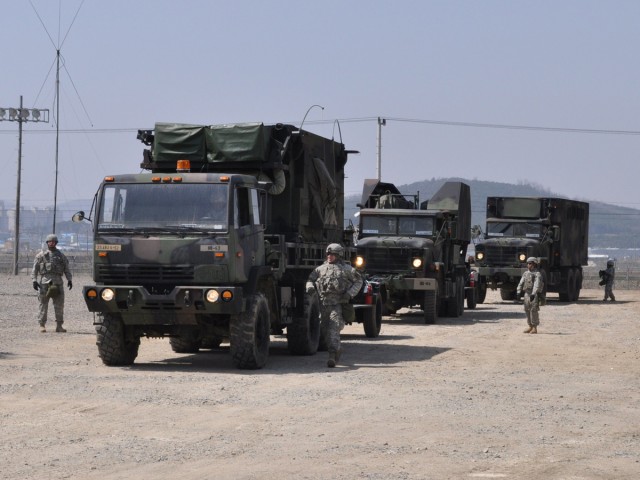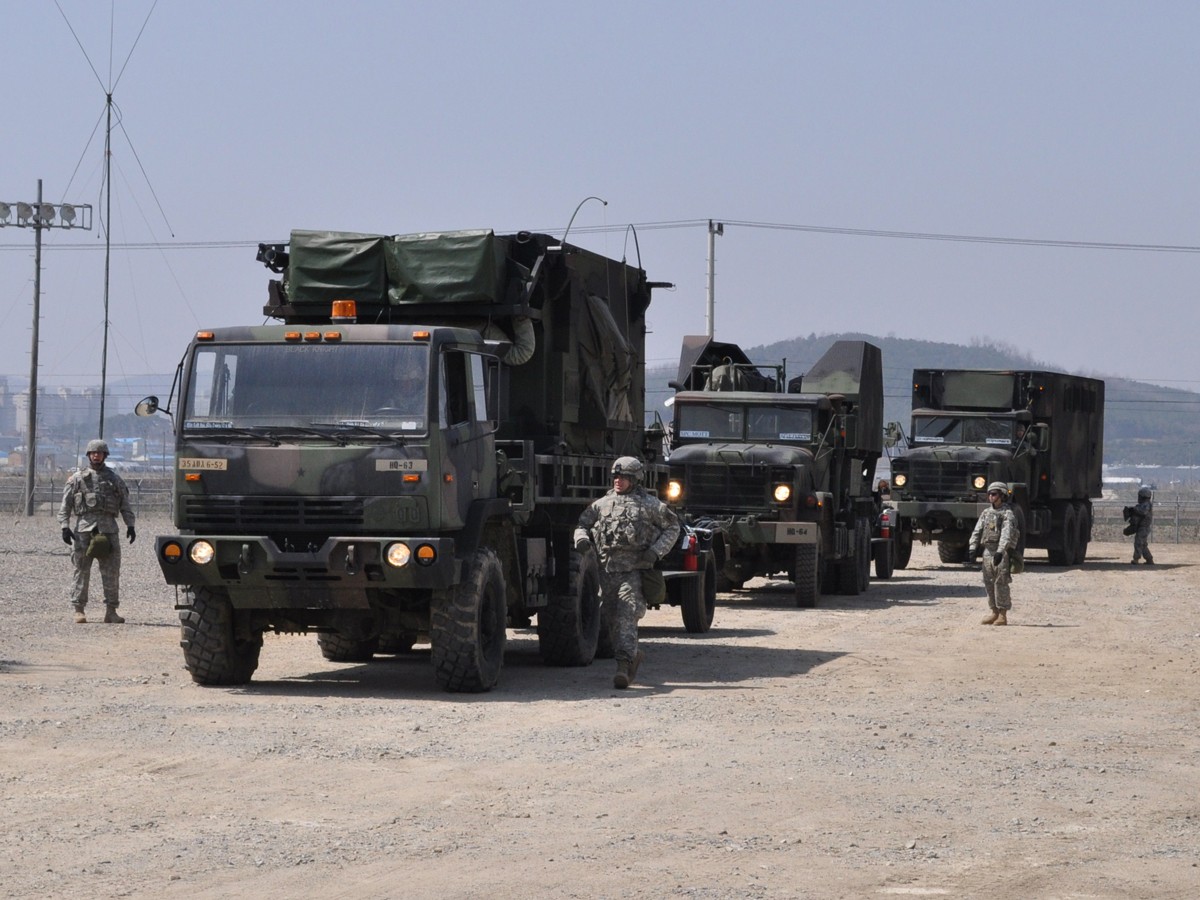SUWON AIR BASE, South Korea - Capt. Carlos Tristan and Chief Warrant Officer 2 David Bates sat quietly inside the compactly-spaced Tactical Control Station, both reviewing one final time the maintenance record for their equipment.
The two leaders observed every miniscule detail, flipping the record pages back and forth to ensure no mistakes slipped through their eyes. Outside of the TCS, darkness engulfed the air base as temperature hovered just above freezing.
As the senior officer in charge of Fire Direction Section of 6th Battalion, 52nd Air Defense Artillery Battalion, Tristan knew that he had the paramount responsibility for the success or failure of his assigned mission - to lead his crew to a successful Patriot gunnery certification.
He also knew that the key to success is attention to detail, not only in the execution of the crew drills, but also in the studious up keep of the maintenance records.
The Fire Direction Section serves as the command and control nodule for an air defense artillery battalion. Moreover, FDS has the important mission to manage air battles and de-conflict tracks for the firing batteries underneath.
It has only been a week since Tristan officially took over as the officer in charge of the FDS, but the San Antonio native was already demonstrating unspoken confidence and proficiency.
Furthermore, whenever he felt he needed support and guidance, Tristan could always look to Bates, the battalion's primary tactical director and the officer in charge of his first crew.
Bates is a veteran air defender with over 14 years of service. The Phoenix native had proven himself to be the subject matter expert in air defense operations during his last assignment as the battery trainer.
"I am completely confident in the FDS' warfighting capabilities," Bates reassured Tristan.
"I felt pretty good about passing the evaluation ... I have an amazing group of Soldiers on my team who work extremely well together," said Tristan.
But there is still mounting pressure on the back of Tristan's mind. "At the end of the day, it is all about being able to fight the fight in accordance with doctrine and standard ... and you really only get one shot to prove to the evaluators that you can achieve just that."
In a few hours, Tristan and Bates will get that one shot.
Only a couple of blocks down the road, Spc. Mary Mott could not fall to sleep. She was excited but also anxious. It was a mixture of emotions all rolled into one.
As the team leader for the Antenna Mast Group under the Fire Direction Section, Mott was responsible for training new Soldiers on the team. Only a couple months prior that Mott herself was considered the new Soldier, but Mott has matured so quickly that she was able to earn the spot of team leader.
This week marked the one year mark for Mott's tour in Korea. She has since enrolled in the Army Incentive Program to stay one more year with her team. She knew in her heart that it was the right decision.
The 24-year-old Appalachian State University graduate had a sound training plan for his Soldiers.
"The training took months ... and it took place in three phases," explained Mott. "I first had the new crew study the technical manuals, and then I have them observe the experienced crews conducting their drills, and finally I have them execute drills themselves under my close supervision."
"It was a good training plan and I knew my crews were ready," Mott added.
In a few hours, she will get the chance to prove that she was right.
Pfc. Davey Martin is looking up at the ceiling of his room. He, too, was feeling anxious about the evaluation.
It has been only six months since he first saw the imposing Iron Horse Statue outside of the battalion headquarters.
Martin said, "Time really flew by when you have so much to learn in such a short amount of time."
As a 25F series MOS Soldier, the 20-year-old communication specialist never learned about the information coordination central, the equipment he is currently assigned to, while he was going through advanced individual training at Fort Gordon, Ga.
"Since I got to the unit, I was able to learn how to operate every single radio inside the ICC and everything else I need to learn communication-wise to get us through the air battles," said Martin, who is assigned to the first crew under the Fire Direction Section.
"Thankfully I had a wonderful group of leaders and first line supervisors in FDS that really cared for me and ensured I am trained and trained well," the Alabama native added.
One of his first line supervisors was Mott.
The evaluation will put to test everything Martin has been training for in the last couple of months. All the sweat and efforts will pay off when they become certified in the next few hours, Martin constantly reminded himself. He forced himself not to think otherwise.
The gunnery evaluation is an extremely important event for an air defense artillery unit. It poses grueling physical and mental challenges to all air defense Soldiers.
The first portion of the evaluation consists of a thorough inspection of equipment mission capability and maintenance paperwork. Evaluators will examine every piece of equipment and all paperwork with a fine-toothed comb to catch inconsistency. Indeed, many units tend to fail the evaluation within the first half hour of the inspection.
The second part of the evaluation is the simulation of wartime situation during which, a firing battery, or in this instance, the battalion Fire Direction Section, receives a movement order and must road march and emplace all its equipment onto another location and then quickly assume posture to conduct and manage air battles against hostile aerial threats.
To add to the stress is the fact that the entire process is a timed event.
Needless to say, a lot of training goes into the preparation phase.
The Battalion Fire Direction Section, as the higher echelon unit above firing batteries, must face another unique challenge
"The hardest part is really the coordination ... for the [FDS] to successfully pass its certification, it relies on our subordinate firing units to do their part and provide us with timely support," explained Tristan. "This is a criterion that is unique to the FDS."
Fast forward the time to the next afternoon, the FDS team is about to find out whether their hard work and efforts have paid off.
As the dust settled and the FDS vehicles are finally emplaced on their new location and ready to defend the South Korea airspace, all there is left to do for the team is to wait for the results.
"Time always seem to pass slower during waiting time after evaluation," said Mott.
Finally, the evaluators came out and smiled.
"You could hear on the headset the cheering of Bates and his crew inside the ICC," Tristan recalled.
Mott gave her crew high-fives as she told them, "we put our best foot forward and we succeeded."
As Bates and his crew came out of the ICC, Tristan greeted them with a big hand shake and words of congratulations.
"We can celebrate now but the battle is not over," Tristan reminded everyone. "Remember that even though the FDS has passed today, our brothers in communication relay group and other firing batteries will be conducting their [evaluations] next week."
"Let's do everything we can in our power to support them." Bates concluded. "In the air defense world, nobody can successfully carry out the mission by himself."


Social Sharing